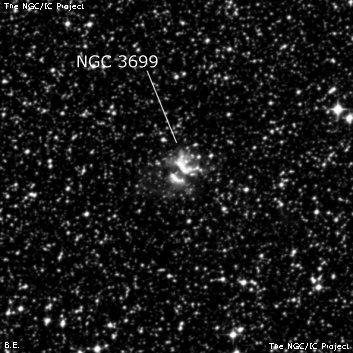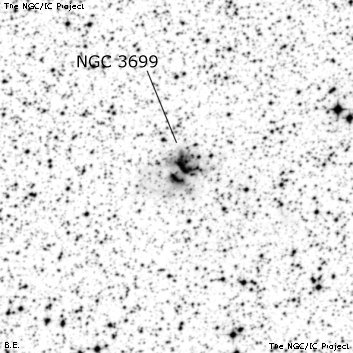NGC/IC Project Restoration Effort
(This is a very very beta version)
NGC3699


Basic Information
Location and Magnitude
Right Ascension: 11:27:57.2
Declination: -59:57:27
Constellation: CEN
Visual Magnitude: 11.3
Historic Information
Discoverer: Herschel J.
Year of discovery: 1834
Discovery aperture: 18.3
Observational
Summary description: B, pL, iR, pgpmbM
Sub-type: PN
Steve's Notes
=====
NGC 3699
24" (4/5/08 - Magellan Observatory, Australia): this showpiece planetary appeared very bright, fairly large, ~70" in diameter and gave an excellent contrast response using an UHC filter at 200x. The planetary is bisected by a prominent, broad dark rift that slashes through the planetary from WSW to ENE (like Centaurus A!). The northern lobe is the more prominent: both larger and brighter. The shape of this lobe is semicircular with a round, outer periphery but with a fairly straight edge SW-NE in the interior due to the dark rift. The center of the dust lane is south of the geometric center of the planetary, giving an asymmetric distribution to the lobes. The rift itself is widest at the ENE end and tapers down towards the WSW end. Superb view at 350x as the extra magnification increases the contrast and confirms that the south lobe is fully detached by the dust land at the WSW end. The compact planetary He 2-67 lies in the same field 11' SE.
13.1" (2/17/04 - Costa Rica): at 100x, this planetary appeared moderately bright and large, ~60"-65" in size. There was a good contrast gain with a UHC filter at 105x and 166x and it appeared brightest on the north side of the planetary. A dark rift running WSW-ENE appears to nearly detach the smaller and fainter southern section.
18" (7/7/02 - Magellan Observatory, Australia): at 128x this interesting planetary is moderately bright, fairly large, ~70" in diameter with some faint stars superimposed. With the UHC filter the appearance is very unusual with a dark rift bisecting it in a WSW-ENE orientation just below the geometric center. At 228x, the northern "hemisphere" is both larger and brighter with an irregular surface brightness. A mag 13 star is ~1' NW. This is a fascinating planetary set in a beautiful Centaurus star field with an appearance similar to faint HII region or a small version of Cen A!



